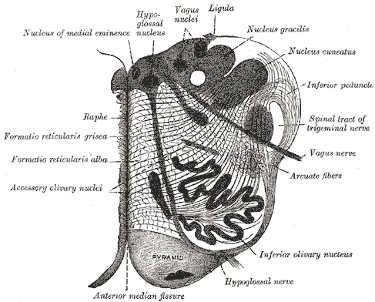The medulla oblongata or simply medulla is a long stem-shaped brain structure which comprises the lower section of the brainstem. It is in front of and partly under the cerebellum.
The cardiac, respiratory, vomiting and vasomotor nerve centers are contained in the medulla.
Consequently, it handles the autonomic functions of breathing, heart rate and blood pressure as well as the sleep-wake cycle1.
An older and lesser-used term for the medulla oblongata is the bulb. In current-day clinical usage, the word bulbar – for example, bulbar palsy – is held over for terms relating to the medulla oblongata, particularly for medical conditions.
Medulla Oblongata Function
The medulla oblongata connects the higher levels of the brain to the spinal cord and is responsible for several functions of the autonomic nervous system.
One medulla oblongata function is the control of ventilation through signals from the carotid and aortic bodies. Respiration is mediated by groups of chemosensors.
These sensors detect changes in blood acidity. For example, if the blood becomes too acidic, the medulla oblongata sends electrical signals to intercostal and phrenic muscle tissue to increase their contraction rate and increase blood oxygenation.
The ventral respiratory group and the dorsal respiratory group are neurons involved in this regulation. The pre-Bötzinger complex is a cluster of interneurons involved in the respiratory function of the medulla.
The cardiovascular centre performs another function in the medulla oblongata. Normally, the heart beats without central nervous system control. But in certain situations, like exercise or major trauma, the cardiovascular centre is responsible for altering heart rate. It also mediates respiratory sinus arrhythmia.
The vasomotor center helps other parts of the medulla oblongata regulate blood pressure, altering vascular smooth muscle tone.
Other centers regulate reflexes such as vomiting, gagging, coughing, sneezing and swallowing.
Medulla Oblongata Anatomy
The medulla can be considered as having two parts:
- an upper open part where the dorsal surface of the medulla is formed by the fourth ventricle
- a lower closed part where the fourth ventricle has narrowed at the obex in the caudal medulla, and surrounds part of the central canal
External surfaces
The anterior median fissure contains a fold of pia mater, extending along the medulla oblongata length. It ends at the lower border of the pons in a small triangular area, termed the foramen cecum.
On either side of this fissure are raised areas termed the medullary pyramids. The pyramids house the pyramidal tracts – the corticospinal and the corticobulbar tracts of the nervous system.
At the caudal part of the medulla these tracts cross over in the decussation of the pyramids obscuring the fissure.
Some other fibers that originate from the anterior median fissure above the decussation of the pyramids and run laterally across the surface of the pons are known as the anterior external arcuate fibers.
The region between the anterolateral and posterolateral sulcus in the upper part of the medulla is marked by a pair of swellings known as olivary bodies (also called olives). They are caused by the largest nuclei of the olivary bodies, the inferior olivary nuclei.
Fasciculi
The posterior part of the medulla between the posterior median sulcus and the posterolateral sulcus contains tracts that enter it from the posterior funiculus of the spinal cord. These are the gracile fasciculus, lying medially next to the midline, and the cuneate fasciculus, lying laterally.

Medulla oblongata section view at about the middle of the olivary body. Credit: Henry Gray, CC-BY
These fasciculi end in rounded elevations known as the gracile and the cuneate tubercles. They are caused by masses of gray matter known as the gracile nucleus and the cuneate nucleus.
The cell bodies in these nuclei are the second-order neurons of the posterior column-medial lemniscus pathway, and their axons, called the internal arcuate fibers or fasciculi, intersect from one side of the medulla to the other to form the medial lemniscus.
Just above the tubercles, the posterior aspect of the medulla is occupied by a triangular fossa, which forms the lower part of the floor of the fourth ventricle. The fossa is bounded on either side by the inferior cerebellar peduncle, which connects the medulla to the cerebellum.
The lower part of the medulla, immediately lateral to the cuneate fasciculus, is marked by another longitudinal elevation known as the tuberculum cinereum. It is caused by an underlying collection of gray matter known as the spinal trigeminal nucleus.
The gray matter of this nucleus is covered by a layer of nerve fibers that form the spinal tract of the trigeminal nerve.
The base of the medulla is defined by the commissural fibers, crossing over from the ipsilateral side in the spinal cord to the contralateral side in the brain stem; below this is the spinal cord.
-
Waldman, Steven D. (2009-01-01), Waldman, Steven D. (ed.), Chapter 120 – The Medulla Oblongata, Pain Review, Philadelphia: W.B. Saunders, p. 208, doi:10.1016/b978-1-4160-5893-9.00120-9 ↩︎
